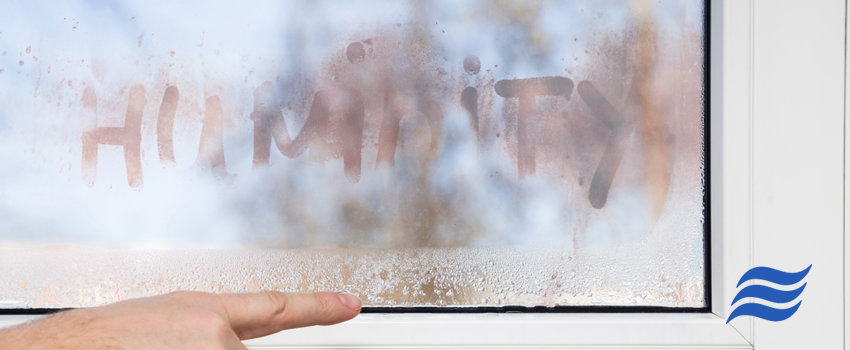
How To Remove Humidity From Your Home
Not only do air conditioners cool your home during the hot summer months, but they can also dramatically reduce the humidity levels in your house.
Controlling humidity levels in your home influences how comfortable you are and is directly related to energy reduction and AC/home maintenance costs. Too little or too much humidity causes problems for homeowners.
Humidity is water vapor in the air and is commonly defined as “relative humidity”. Relative humidity is the percentage of water vapor in the air at a specific temperature, as compared to the amount of water vapor the air is capable of holding at that temperature. Warm air can hold more water vapor than its counterpart, cold air.
With low humidity levels, the moisture in your body evaporates quickly and you’re left feeling chilled. We’ve all experienced dry air in the winter which causes static electricity, dry lips, skin and hair, itching and chapping, and scratchy throats and noses.
With high humidity and more moisture in the air, you can see condensation on the windows, moldy bathrooms, wet stains on the walls and ceilings, musty odor and a general wet clammy feel to the air. Structural damage and rot can also be a result of excess moisture in the air with high humidity.
Here are some ways to make sure your current A/C system is removing humidity properly:
1. Keep Your Coil Clean
Your home comfort system relies on air movement. When your indoor evaporator coil is smothered in dust and dirt, it can’t breathe, and it can’t do its job of removing the heat and humidity that it’s designed to remove. If your coil stays dirty for extended periods of time, your system can freeze up, it can cause components to fail way before their time and your home can get very humid.
The simple solution? Change and clean your filters according to the manufacturer’s specification. This should eliminate the problem because when the air filter is doing its job of collecting particles from the air, your A/C’s coil is kept cleaner.
When the filter gets dirty, your system is starved for air and has to work a lot harder. In that process of trying to suck in enough air to function, it pulls excess dust and dirt from the filter and it sticks to the wet evaporator coil. If you catch this early, all you will need is professional cleaning. If you let this go on for an extended period of time, you may be looking at a complete shutdown of your system or failing capacitors and motors due to the excessive load on the system.
2. Adjust Your Fan Speed On Your Air Handler
Check to see if your A/C is set to original factory settings or if it has been fine-tuned to meet the needs of your specific home.
Many HVAC companies just install and turn on equipment during installation – they never fine tune it to your home’s demands. This isn’t a one-fits-all solution – each climate (and each property) has different needs.
In our hot and humid summer climate, A/C systems move air at a rate of 350 CFMs per ton (don’t worry if this sounds like gibberish to you, CFMs are just the measurement of airflow/air quantity). In day-to-day life, this can vary depending on where the unit is installed on your property, but generally speaking humid climates need to work at 350 CFM/ton.
Most A/C systems manufactured today are geared up to move more air a lot faster. If you are trying to eliminate humidity, moving air faster will not solve the problem.
Changing your air handler speed to 350 CFM will slow the air down and move it over a colder coil. When it’s colder, it will remove more moisture from the air, and you’ll also get to your desired thermostat setting quicker.
If you’re lucky enough to have a variable speed air handler, it should solve a humidity problem automatically.
3. Install A Thermal Expansion Valve
Thermal expansion valves (otherwise known as a TXV) come as standard on the latest high-efficiency A/C models. If your A/C is slightly older or a lower efficiency model, installing a TXV is absolutely essential.
The thermal expansion valve measures and maintains the level of refrigerant that goes into your A/C’s evaporator coil. Once vaporized, the refrigerant vapor takes absorbed heat from the air inside the home and discharges it outside via the condenser coil.
In hotter weather, more refrigerant is needed for your system to work at optimum performance and reduce the humidity in your home.
By installing a universal thermal expansion valve, not only can you reduce the humidity in your home, but you can also run your system at a more efficient rate – which saves you money and can lengthen your A/C’s lifespan.
4. Check Your Refrigerant Charge
An integral part of any A/C unit is the refrigerant. It keeps everything running smoothly and efficiently. If you’ve noticed any of these symptoms lately, you might be running low on coolant:
- An unexplained increase on your electric bills
- High humidity levels
- A build-up of ice on the outside unit
- A hissing noise is coming from the unit
Low refrigerant levels can cause your unit to struggle to do its job – it won’t be able to get rid of the excessive heat and humidity building up in your home. If left, low refrigerant levels can cause a lot more problems within you’re A/C, including coils freezing and compressors seizing up.
Low refrigerant doesn’t ‘just happen’ – if it’s running low, there’s a leak somewhere that needs to be fixed as soon as possible. Topping it up is a short term solution, this is a problem that is best solved quickly. Low refrigerant is the catalyst for many expensive problems.
During your annual maintenance inspections, your HVAC company should check all your refrigerant levels and diagnose any problems immediately. If you’re worried your A/C refrigerant charge is running low, get a professional in immediately to sort it out for you.
5. Consider Upgrading To A High-Efficiency System
When it comes to A/C units and our climate – the more efficient, the better!
While it may be true that just about any system will deliver cold air into your property, the question really is, how efficient is your AC unit in turning your cash into cold air? Will it cool your home really fast, but not stay on long enough to remove the humidity? Will it cycle on and off a lot, which ends up wasting energy and raising your electricity bill? The latest technology, high-efficiency A/C system will keep you cool, reduce the humidity in your home and lower your electricity costs.
Going back to our second point on this list, most high-efficiency air conditioners come equipped with variable air speed adjusters. Which are really cool (no pun intended). They vary the motor speed, allowing the system to stay on long enough to reduce the humidity and maintain a low energy draw which keeps the “turn on” spikes to a minimum and maintains a more even temperature.
This gives your system more control over efficiency, performance and automatic humidity removal. For instance, the Carrier Infinity 20 has load matching performance with speed ranges between 40% and 100% capacity.
Alternative Ways To Reduce/Eliminate Humidity In Your Home
- Seal All Your Home’s Ducts and Connectors Correctly
By sealing and insulating your AC system, not only will it work better and keep energy costs down, but you’ll also prevent moisture from entering the duct system from other areas. Basically, you’ll stop inadvertently paying to cool your attic via leaks. - Get A Whole-House Dehumidifier
This is pretty much the last resort to your humidity problems. You can install a whole house dehumidification system to solve the issue, but they can be incredibly costly.
If you feel your system isn't working as efficiently as it should, schedule an HVAC inspection to figure out the cause today – and make sure you're not left in a hot mess this summer!
Check out our other blogs for some great HVAC advice:
- Monthly Guide To HVAC Maintenance
- The 5 Biggest HVAC Myths
- How to Get Your AC Read For Summer After A Long Winter
- Pet Owners! Get More Life Out Of Your HVAC Unit With These 6 Tips
- Gas Leaks and How to Prevent Them
- How to Remove Humidity From Your Home
- Signs of a Damaged Furnace Heater
- 5 Biggest HVAC Myths
- 5 Tips For Spring Cleaning Your HVAC System
